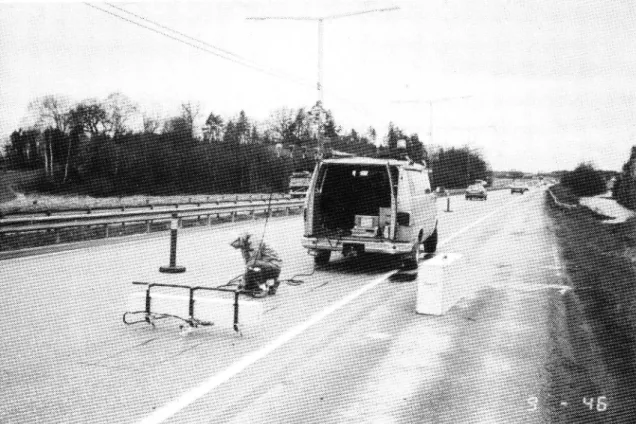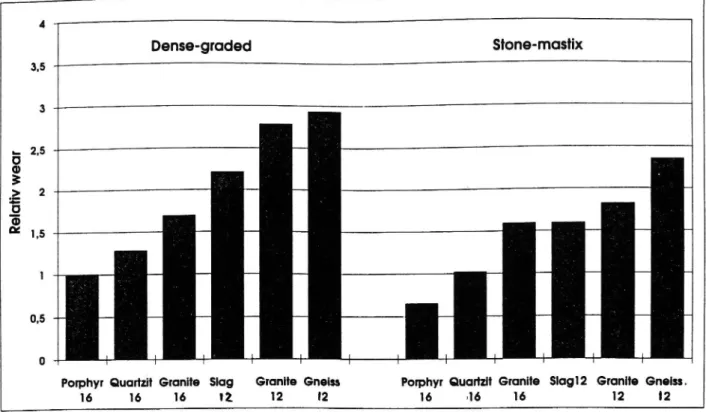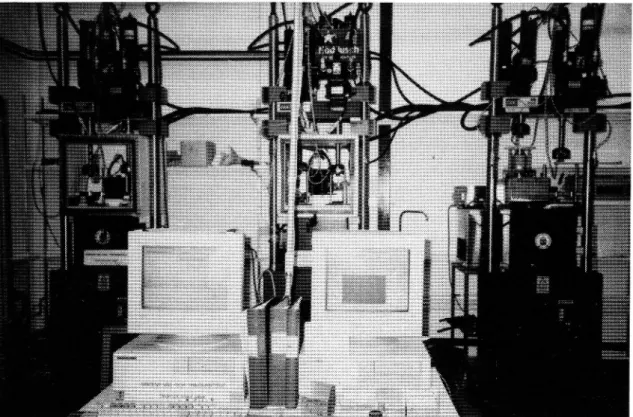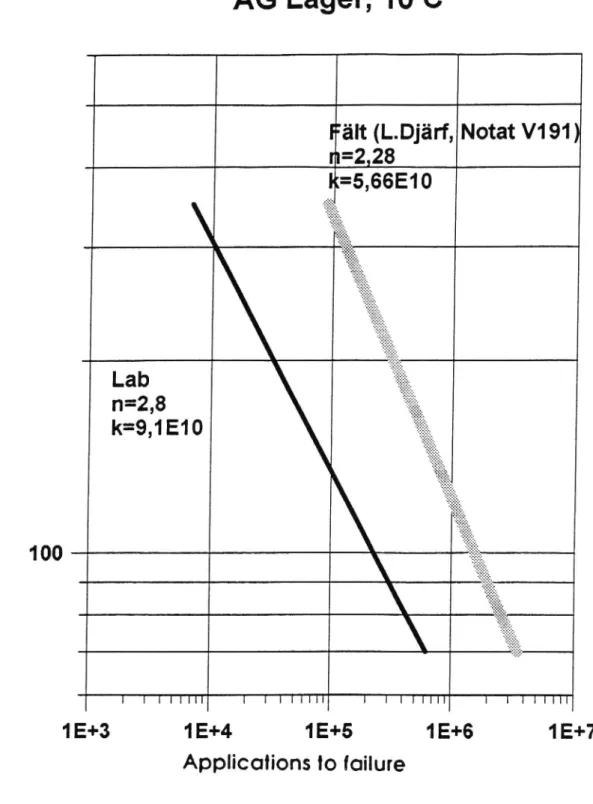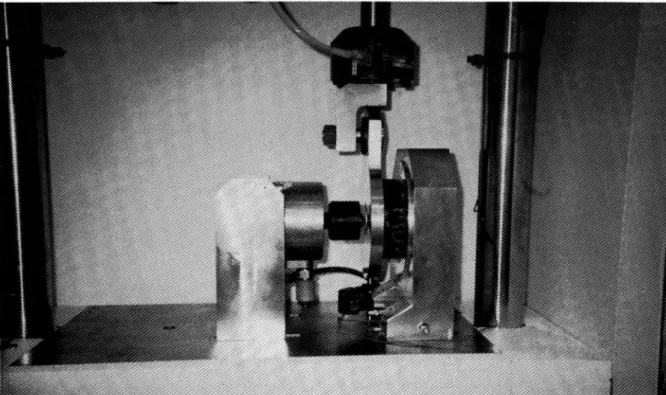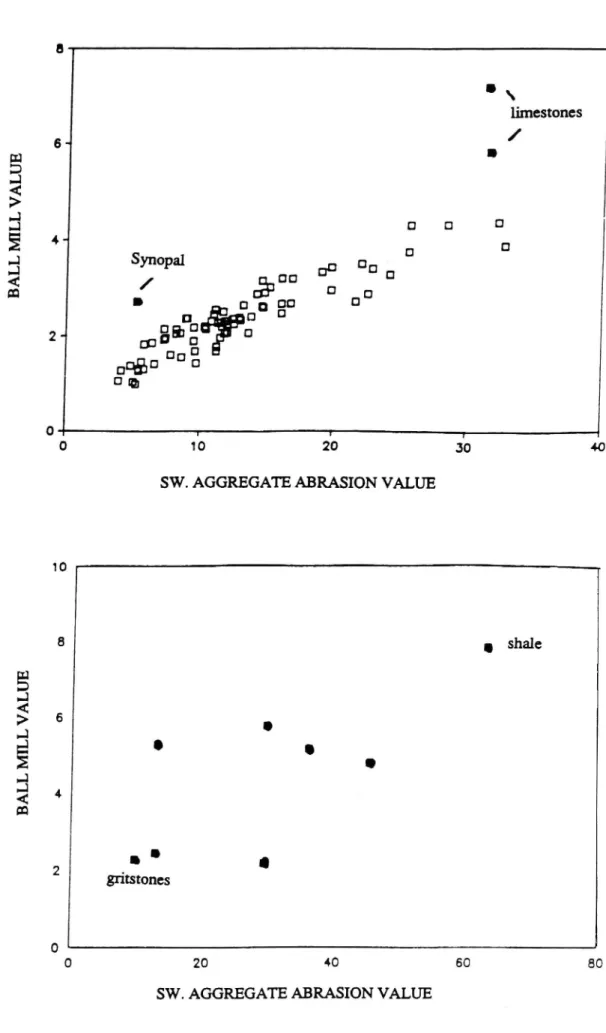VTI särtryck
Nr 205 0 1994
Testing of bituminous mixes and aggregates
examples of Swedish experience
Peet Höbeda
Paper prepared for The 2nd International Symposium
Highway Surfacing, University of Ulster,
January 27 28, 1994
Väg- och
transport-forskningsinstitutet
VTI särtryck
Nr 205 ' 1994
Testing of bituminous mixes and aggregates
examples of Swedish experience
Peet Höbeda
Paper prepared for The 2nd International Symposium
Highway Surfacing, University of Ulster,
January 27 28, 1994
(db
Väg- och
transport-farskningsinstitutet
,
ISSN 1102-626XSUMlVIARY.
TESTING OF BITUMINOUS MIXES AND AGGREGATES EXAMPLES OF SWEDISH EXPERIENCE.
P.Höbeda, Swedish Road and Transport Research Institute (V'I'I).
A new system of performance based specifications is to be used to an increasing extent in
Sweden. The system takes into account the functional properties of the road surface which
must be ful lled during a certain time. There is also a need to describe the "functional
proper-ties" of bituminous mixes with the aid of relevant laboratory tests and a description is given of
current research at V'I'I.
Since the late 19603 developement of bituminous surfacings has largely been focussed on improving wearing resistance to studded tyres. Much progress has been made in recent years and the levels of wear observed earlier should not reoccur. The signi cant in uence of aggre-gate quality is now well understood and aggreaggre-gate tests exist that permit prediction of the performance of a particular type of surfacing. New types of surfacings such as stone-mastic
asphalt are being speci ed and used to an increasing extent. There are also some bene ts from
studded tyre wear in the form of improved skid resistance of surfacings both in summer and
winter.
A system for testing laboratory rolled slabs with known composition, inserted in road surfa-cings or used in a road simulator, has been developed at V'I'I. The road simulator makes it possible to test new materials or road surfacings in a very cost-effective manner and the results correlate very well with road wear.
* Research is also being directed towards testing other "functional properties" of bituminous
mixes of different types such as stiffness, rutting by plastic deformation and cracking by fati-gue, as well as durability properties such as ageing and stripping. This work is still in progress and only certain preliminary results are outlined.
Some special problems concerning testing of aggregates in Sweden are also brie y described and various aspects relating to the work of CEN TC154 Aggregates are discussed.
1. INTRODUCTION.
In Sweden, there is a trend against the introduction of perfomance based speci cations
(Lindahl 1992) whereby a contractor can build a road or maintain a surfacing that provides a
stipulated function for a certain number of years. The contractor himself must carry out
main-tenance work during that time period, if necessary. The aim is to specify functional properties
of the road surface such as rutting, evenness, cracking and skid resistance. Measurements of surface conditions are carried out mainly using the RST vehicle, a multi-function Laser Road
Surface Tester (Henriksson and Olofsson 1993). Contractors have freedom to propose their
own designs and are not restricted by the Swedish Road Administration Speci cations (SRA)
as before. Also material related research is regarded as a future responsibility of the contracting and material industry.
A lower level of "performance based properties" deals with the properties of the bituminous mix itself as determined in the laboratory. VTI has been active in investigations commissioned by the SRA during the last few years. These investigations are continuing during 1994 and this
report can therefore only summarize some preliminary results. The studies of wear from
stud-ded tyres are at the most advanced stage and will be discussed in more detail than other
"functional properties" such as stiffness, resistance to rutting by plastic ow, fatigue and
du-rability (ageing and water sensitivity). Low temperature cracking problems have not been con-sidered very severe in Sweden, but research on this subject is being carried out by the Royal Institute of Technology in Stockholm.
One dif culty in this work has been the active research in the international area, leading to new
tests and mix-design methods for bituminous mixes. Examples are the SHRP Asphalt
Pro-gramme in the USA, ASTO in Finland, the Asphalt Research ProPro-gramme in Australia. In
Fran-ce, a set of functional tests has existed since the 19703 and development has also been carried
out at the University of Nottingham. Also, CEN TC 227 Road Materials has begun to propose
methods intended as future European Standards. Thus, it is very important to consider all the
work being conducted in various countries.
2. WEAR FROM STUDDED TYRES: CONSEQUENCES AND TEST METHODS.
In Sweden, as in other Scandinavian countries except Denmark, wear from studded tyres has been the main challenge to asphalt technology and most research work has also been devoted to solving this problem. In recent years, much progress has been made in this area and it can
now be stated that the wear problem is under control. The reasons for this are the development
of new wear-resistant surfacings, a better understanding of the importance of aggregate qua-lity and the introduction of new types of less aggressive lightweight studs (Gustavsson 1993).
- New, studless winter tyres have also gained market shares even if their effectiveness in icy
conditions is somewhat inferior to studded tyres, a conclusion supported by Japanese
experi-ence after their studded tyre ban in 1991 (Kaku et al 1993).
The bituminous surface mix now gaining an increasing share of the market in Sweden is the stone-mastic asphalt mix of German origin with a high stone content, small amount of ne aggregate, but a high amount of ller and binder (mastic). A small amount of bre is added to prevent binder run-off and prevent segregation during handling. The aggregate must be of good quality. For high traf c volume roadways, lorry transports of wear resistant aggregates may be economical over distances as great as several hundred kilometres. This type of
surfa-cing will develop an "armoured surface", rich in wear resistant aggregate. Typical aggregate
size is16 mm, although larger sizes produce some gain in wear resistance.
The surface of a stone-mastic asphalt will develop a favourable macro-texture, leading to some noise reduction and diminished spray and skid resistance problems in wet weather compared with a dense asphalt concrete. This is especially valid if the maximum aggregate size is not too
large. In fact, a porous asphalt will in Swedish conditions, achieve about the same noise
reduc-tion properties after some time when the pores have become clogged with debris. The macro-texture is also favourable from the viewpoint of resistance to skidding. Wear from studded ty-res prevents excessive polishing of aggregates as the surfaces are roughened up and the sum-mer period is too short for excessive polishing of hard aggregates to occur. In fact, the most wear resistant Swedish aggregates do not have good Polished Stone Values (a test not consi-dered necessary in Sweden). Probably, a good macro-texture may compensate for a lack of micro-texture. Can the high Polished Stone Values demanded in Britain depend on the exces-sive use of Hot Rolled Asphalt, a type of mix that does not provide a very good macro-textu-re?
The increasing use of stone-mastic asphalt poses certain problems, with an excess of ne agg-regate which is hard to market. If the unes are not too remote from urban areas, it may be possible to manufacture thin surfacings with maximum aggregate sizes of 4 or 8 mm and thus use the surplus ne aggregate. Such mixes can be used when wear is not a particular problem. Contractors are now supplying such mixes, basically designed according to the same concept as for stone-mastic asphalt made with coarser aggregate, but usually with polymers. Also, at-tempts have been made to increase the ller content in the surplus ne aggregate by milling, as
ller often has to be purchased for stone-mastic asphalt mixes. Another possibility would be to use ne aggregate, stabilised with hydraulic or bituminous binders, e.g. in road subbases, but this type of design has not been speci ed and probably has not been considered economical. Such designs may appear in the future, when performance based speci cations allow greater
freedom for contractors. Such designs, with a bound subbase, should give road constructions with a better bearing capacity.
2.1. Testing road wear.
Testing of aggregate will be treated in para. 4. Laboratory testing of the wear resistance of bi-tuminous mix is not an easy task. Some apparatuses have been studied and all show some
cor-relation with road wear of "normal" bituminous mixes, although there are certain problems.
The originally German Tröger apparatus has been abandoned because of poor precision. The Finnish PWR machine has been considered, but it cannot be used on cores from asphalt surfa-cings which is considered essential in Sweden. At present, work is in progress with a "wet steel
shot apparatus" originally developed in California but also used in modi ed form in Germany
(TU Munich). A Swedish contractor recently introduced this method in Sweden and VTI is participating in a joint research project. This apparatus can also be used in fretting studies, e.g. with bituminous mixes used in air eld pavements.
In recent years much work has been devoted to developing a new system for studying wear under different road conditions. Full-scale test roads, i.e. test sections for comparing different aggregates, are very expensive and it is dif cult to control all the variables in the asphalt plant and in laying operations, especially when small batches are being produced. Therefore, a new test system has been developed at VTI which involves small slabs of bituminous mix manufac-tured and rolled under very realistic conditions. The composition and voids content can be controlled in the rolled slabs (96x75 cm, thickness normally 40 mm). Test slabs are rmly
in-serted and levelled in the outer wheel-path of road surfacings after milling out the proper
opening in the wearing course. Reference studs for wear measuring lines (6 for each slab) are mounted in the adjacent wearing course. A very precise laser pro lometer (accuracy about 0.01 mm) is used for wear measurements, performed in autumn and spring (Figure la). The
transverse distribution of traf c is monitored. Thus, wear can be distinguished from other types
of rutting. Over 120 slabs have been inserted in roads under differing conditions to study the importance of variables such as mix type, aggregate quality, traf c conditions such as speed
and climatic conditions etc.
Another development has been the upgrading of VTI s circular road simulator (Figure la,
dia-meter about 5 m). Tests now can be made at realistic speed (85 kmh) and full climate control
(Jacobson 1993). When manufacturing slabs for "implantation" in the road, extra slabs have been manufactured for testing in the road simulator as well as for extraction of cores for labo-ratory testing. Good correlation has been established between road wear and the wear on
"twin" slabs in the road simulator using a wet track and a temperature just above 0°C
on the road and in the road simulator, especially when measuring wear. It is now possible to test new materials (e.g. aggregate type as in Figure 2a) and mix types (Figure 2b) in a rapid and cost-effective way using the road simulator. Wear measurements on heavily used roads in-volve risks for personnel and hindrance of traf c.
Knowledge of the aggregate abrasion enables a fairly accurate prediction of the wearing pro-perties of a certain mix as there is a good correlation between aggregate tests (parai4) and road wear. Knowing the percentage of coarse aggregate, a further improvement of the prediction can be made as certain provision is made for the mix type. However, the road simulator has made it possible to compare different mix types in a very realistic way, e.g. a stone-mastix asp-halt with maximum aggregate size of 8 mm can be as wear resistant as an aspasp-halt concrete with maximum size of 16 mm. Such knowledge also enables development of a wear model
appli-cable for functional speci cations, based on the wear properties of a mix, traf c volume,
per-centage of studded tyre traffic, transverse distribution of traf c, speed limit etc. This work is
being performed by L-G.Wagberg at VTI. A model used for function speci cations must also take into account other types of rutting besides wear.
3. TESTING OF OTHER " FUNCTIONAL MIX PROPERTIES" THAN WEAR.
Closed loop servo-hydraulic MTS apparatus has been the main piece of equipment used at VTI for testing properties of bituminous mixes other than wear. Some Nottingham Asphalt Testers
are in operation in other Swedish laboratories. The MTS apparatus was purchased in the late
1980s with the aid of the National Road Administration. This special piece of equipment can handle up to 6 climate controlled specimens at the same time. Control of the system and data
acquisition utilises ATS Software (Figure 3a). The indirect tensile strength test has been used
in a repetitive manner, for the characterisation of the mix stiffness and fatigue properties, in
principle as described by Said (1990), Figure 3b. It has been considered important to be able to test cores extracted from roads. A data-base is being developed which contains properties of
* test results on Swedish bituminous mixes.
An extensive study has been made of the fatigue properties of typical Swedish base mix using cores from road sections which were part of a Swedish long term pavement performance study (Dj arf and Said 1993). These sections have been subjected to a known amount of traf c and the resulting distress has been investigated. The bituminous road layers were 75-130 mm in thiclmess. Fatigue failures seldom occur in roads with thicker bound layers and also rutting
from studded tyres becomes a problem if the traf c is very intense. De ection bowl
measure-ments have been performed regularly on the sections with the aid of a falling-weight de ecto-meter. The strain in the road base has been calculated using regression analysis developed by HJansson at VTI. The aim of this research has been to develop a fatigue criterion for
mecha-nistic road design, valid for typical Swedish base mix and achieved under relevant conditions.
Thus, it has been possible to correlate the fatigue properties of the cores tested in the
labora-tory (at 10°C) and the fatigue cracking induced during traf c loading. There is a shift factor of about 20, but the slopes of the fatigue curves are not very different (Figure 4). Indications are
that the indirect tensile test is also relevant for fatigue testing, in spite of the rather special
stress distribution in the specimen. It should be considered for standardisation by CEN TC
227.
Resistance against plastic deformation has been tested using both static and repetitive loading
creep tests of the type suggested by CEN TC 227. Using a specimen wider (e.g.150 mm) than the loaded circular area (e.g.lOO mm) seems to give more reliable results as some con nement is achieved (Ulmgren 1993) In a creep test, a consolidation occurs, but no rearrangement of particles is caused by shearing forces as in road conditions under tyre loading. Because these tests have limitations, a repetitive type of shear test has been developed at VTI and has shown promising preliminary results, although experience is still very limited. The apparatus is shown
in Figure 5a and some results with extracted cores of asphalt concrete and stone-mastic asphalt
are given in Figure 5b. The shear modulus is in uenced by test frequency but is fairly similar for both mixes, especially at 400C. Field validation of rutting by plastic deformation is dif cult as it is not a continuous process like road wear, but can occur in a fairly short time during un-favourably warm summer periods. Attempts are being made to modify our road simulator for such veri cation testing. A laboratory type of wheel-tracking apparatus is lacking at present, but should be purchased.
The tests used for determination of properties of bituminous mixes have been developed for
dense asphalt concrete and are not always relevant for other types of mixes such as
stone-mas-tix asphalt and porous asphalt concrete. Stone-rich base mixes, with a high maximum aggre-gate size, using bres or "multigrade" bitumens, have also come into use in Sweden. The types of mixes mentioned above work more through aggregate interlock and interaction with other road layers than through cohesion provided by mortar, as in normal asphalt concrete. Testing a small cylindrical specimen or beam may thus give less relevant results. Some sort of a triaxial test would probably be more appropriate, but the mix testing laboratories in Europe have lar-gely abandoned this type of test.
When testing laboratory manufactured specimens, the bituminous mix must be representative
of the plant mix laid on the road. Considerable research as been performed in different
countries conceming the in uence of compaction in the laboratory and eld on particle
orien-tation, which affect the mechanical properties. The differences in binder properties that may occur when manufacturing mixes under laboratory and eld conditions is an area of research
being comparatively neclected. Some of the differences in mix mechanical properties, claimed
to depend on compaction, may in fact be due to changes in binder properties. Reasonable
ageing of the binder in fact leads to improved stiffness, rutting resistance and fatigue properties
(but not in the case of very thin surfacings). When testing a bituminous mix according to
SU-PERPAVE, developed by SI-IRP, an oven-ageing procedure for the mix is included in the
te-sting programme in order to achieve a mix that is more representative of eld conditions. Such an ageing procedure is not performed according to European mix design methods, but should be considered. Its in uence could possibly be considered to be a built-in "safety factor". Another factor that in uences the properties of bituminous mix under working conditions is water susceptibility. If the mix is prone to stripping, it is also highly vulnerable to rutting and fatigue cracking because the road is often in a wet condition. Tests are normally performed on dry mixes and may not give correct results. Work on water susceptibility, performed at VTI, has shown that it is easy to obtain exaggerated results under laboratory conditions, e.g. during vacuum saturation, when using high water immersion temperatures etc (Höbeda 1993). Using a weak salt solution, the susceptibility of the mix increases, but only at higher (about 60°C) than normal "working temperatures". The most wear resistant Swedish aggregates are hyd-rophilic, but generally function well in practice. In the new types of stone-mastic asphalt, the
bitumen content is fairly high, which is favourable to ageing and water susceptibility properties.
Hydrophilic aggregates have sometimes performed poorly in porous asphalt or base mixes with low bitumen contents. Introducing bre or modi ers in the mix and increasing the binder con-tent largely overcomes such problems.
4. SOME SPECIAL AGGREGATE TESTING PROBLEMS.
Because of the fairly favourable geological conditions in Sweden for aggregate production, few aggregate tests have been necessary (Hobeda 1989). This is also valid for other parts of Scandinavia such as Finland and Norway (see e.g. Löberg 1990). Consequently, there are no
standardised tests for aggregate durability or " nes quality" in Sweden such as those listed by
CEN TC 154 Aggregates.
The most important test speci ed is for aggregate abrasion, a test related to the British Aggre-gate Abrasion Value. However, this test is planned to be replaced by a wet ball mill test
deve-loped at VTI and accepted in Finland and Norway. It has been proposed by CEN TC 154 as a
Nordic Abrasion Test and is intended for use in countries where studded tyre wear is a problem. Good correlation between test results and road wear has been established in the
A similar test is the French Microdeval, also proposed by CEN TC 154 as the European stan-dard for aggregate abrasion, but not limited to road surfacings. This test was used in limited investigation of Swedish aggregates in the late 19703, in cooperation with LCPC in Paris. The test results did not always agree with eld experience of the aggregates and no further investi-gations were performed. Recently, there was a CEN enquiry on the Microdeval test, which has been rejected by UK. Their experience showed that the test results do not correspond with aggregate performance in road surfacings. Therefore a request has been made for the British
Aggregate Abrasion Value to be introduced as a new CEN proposal. VTI has some experience
with its own test methods, related to both the above tests. Good correlation has been found
between the "Nordic" wet ball mill test and Swedish abrasion test (of the British AAV type).
However, this is only valid if aggregates of igneous and metamorphic rock types are tested. If aggregates consisting of sedimentary rocks, weathered rocks or arti cial aggregates such as
slags are included, the correlation will be poor because of excessive differences in physical
properties such as modulus of elasticity, porosity etc. (Figure 6a). In fact, some aggregates from South-Westem England have been tested according to the two Swedish aggregate wear
tests in 1987 thanks to Dr. D.Cawsey, then at Hat eld Polytechnic (Figure 6b). Only gritstone
(siltstone) lies on the correlation curve for "normal" Swedish aggregates. Some British aggre-gates with particularly high Polished Stone Values would probably correlate badly.
In regard to unbound aggregates under thick asphalt layers, the relevance of a wear test such as Microdeval can be discussed. Fairly soft aggregates, such as limestones (of good quality) and some slags, may in fact give better performance than very hard aggregates which often form aky particles and lead to compaction dif culties. The result will be a less stiff layer than with a weaker aggregate. In Sweden, aggregates weaker than usual can generally be used in an
unbound layer if construction traf c or temporary traf c is avoided.
Besides wear tests, there is a Scandinavian a test for particle shape, using slotted sieves for classi cation, and an impact test for aggregate strength (Höbeda 1989). These tests have per-formed well and are considerably simpler than the corresponding tests proposed by CEN TC154, i.e. akiness index and Los Angeles test. Recent Norwegian work has shown that
there is good correlation between the "Scandinavian type" akiness test and CEN akiness
test. Also, it seems that classi cations for akiness index, worked out by CEN Subcommittees, permit very aky aggregates (Ruud et al 1993). There is also good correlation between the
"Scandinavian type" impact test and Los Angeles test, especially if the aggregate sizes tested
do not differ too much. This is also valid for other types of strength tests, including static cru-shing tests, which is valid if the physical properties of the aggregates, whether natural or synt-hetic, do not differ very much.
Test methods for durability have been discussed in the work of CEN, TC 154. At present, the
list of proposed test methods includes a freeze-thaw test using water and a Magnesium Sulpha-te Soundness Test. No special durability Sulpha-test is speci ed in Sweden because aggregaSulpha-tes with
poor durability are very rare, but a freeze-thaw test has sometimes been used at VTI (Höbeda
1989). A weak salt solution (1%) is used, as former German work (Vogler 1976) and also
VTP s own experiments have shown that there is little degradation when using water. This is
valid even for unsound aggregates. Using a salt solution, such test is not intended for investi-gation of the in uence of de-icing agents, but only to achieve more meaningful results. Similar experience, also considering the relationship with eld performance, originates from Ontario,
Canada (Rogers et al 1988) and Iceland (Petursson 1992). Tests using weak salt solutions have
been developed in both countries.
A single test using a weak salt solution could probably replace the two present proposed CEN tests. The Magnesium Soundness Test, deleted in Ontario in favour of a 3% salt solution freeze-thaw test (Rogers 1988), has been much criticised because of poor precision and doubt-ful relationship with aggregate performance. Also, non-durable aggregates give extremely poor wet ball mill values and are already rejected when using a simpler and quicker salt solution test. A special durability test may be of interest in such cases when there are small amounts of unso-und particles present in a sample.
5. REFERENCES.
Djärf,L, Said,S. Laboratory fatigue properties compared with field performance. 5th
Eurobi-tume Conference, Stockholm 1993.
Gustavsson,K. Tests with lightweight studs in V'ITs road simulator (in Swedish with an
Eng-lish Summary). VTI Rapport 377, 1992.
H'o'beda,P. In uence of aggregate on the durability of road surfacings and testing of aggregates - Swedish experience. Conf. Durability and performance of bituminous highway materials. Hat eld 1989.
Höbeda,P. Laboratory testing of ageing and moisture susceptibility of bituminous mix. Proc. 5th Eurobitume Conference, Stockholm 1993.
Jacobson,T. Wear resistance of bituminous mixes to studded tyres-a novel approach to eld
measurements and correlation with V'Il's traffic simulator. 5th Eurobitume Conference, Stockholm 1993.
10
Kaku,T et al. Skidding accident in winter in Hokkaido by studless tyre. The East-West
Euro-pean Road Conference, Warsaw 1993.
Lindahl,T, Highway Research and Technology Transfer Structures and Mechanisms in Swe-den. Conf. Transportation- A key to Canadian competitiveness, Quebec City, Sept 1993. Loberg,B. High-quality rocks and aggregates for Norwegian highways, Int. Symposium on
Highway Surfacings, Univ. Ulster, 1990.
Petursson, P et al, Aggregates for Pavements. Frost-Resistance test. Building Research
Insti-tute, Unpublished Report 1990.
Rogers,C et al, Development of an uncon ned freeze-thaw test for coarse aggregates. Proc. Annual Conference RTAC.ARTC, 1988.
Ruud,O.E. Flakiness index and ball mill test (in Norwegian). Asfaltindustrins Laboratorium,
Rapport nr 2, 1993.
Said,S. Resilient Modulus by indirect tensile test. Proc. 4th Int. RILEM Symposium, Budapest
1990.
Ulmgren,N. Determination of functional properties of bituminous mix in laboratory stability testing with repetitive creep test (in Swedish). NCC, unpublished report 1993.
Vogler,H. Automatic freeze-thaw tests with aggregates 8-10mm, using deicing agents (in
Figure 1 a) Measuring wear on a test slab, inserted in road surfacing and b) V'I'I s road
4 ___ ___ Dense-graded Stone-mastix 3,5
-a
o 3 .2 2 a a:Porphyr Quartz Granite Slag Granite Gneis: Porphyr Quartz" Granite Slag12 Granite Gnelss. 16 16 16 Iz 12 12 16 »16 16 12 12 3
Porphvrv
Quartzite
2.5ö
0 3 zE
0 n:Dense- Dense- Stone- Stone- Stone- Stone- Dense- Dense- Stone- Stone-
S1one-graded S1one-graded mas x mas x mastix mas x graded graded mastix mastix masiix
12mm 16mm 8mm 12mm 16mm 20mm 12mm 16mm 8mm 12mm 16mm
Figure 2 a) Examples of relative wear as in uenced by a) aggregate quality for dense graded
asphalt concrete and b) In uence of mix type with two aggregates of good wear resistance
115 mm
Figure 3 a) VTI s MTS testing system and b) extensiometers mounted on the specimen for
testing resilient modulus according to indirect tensile strength testing method (Djärf and Said
AG Lager, 10 C
Fält (L.Djärf, Notat V191)
n=2,28
l
i=5,66E10
... ... ... .. ... .-... ....... ... .......... .... ...» ...... ... ._._._.;..... ............ . .. .......... ...... ... ....... ... ....... .... ...... ... ....Lab
...n=2,8
k=9,1 E10
... .... ... '''''''''... ... ... ---..._________Te
ns
il
e
st
ra
in
10
-6
... .... ... .... ... ... ...100
llllllll llllllll llllllll Illlllll1E+3
1E+4
1E+5
1E+6
1 E+7
Applications to failure
N = k (8)A-l1
Said SNTIjan.93
Figure 4) Laboratory and eld based relations between number of load applications to failure
and initial strain level at 10°C. (Number of equivalent 100 kN single axle loads for the eld
1000.00 - 0100 mm g _. S H E A R M O D U L U S , M P a J HABS 16 HABT 16
100-00 I [WWII] 1 IIIHHI I lllfm" I IIIHIH
0.01 0.10 1.00 10.00 100.00
FREQUENCY, Hz
Figure 5 a) VTI s apparatus for repetitive shear testing and b) preliminary results with asphalt
concrete (HAB 16) and stone-mastix asphalt (HABS 16)
8
' x
limestones 6- / m I D ..] <>
1
j 0 D CJE
D
0
j Synopal 00 Do ( / DO D m ä' 0 0 nu D 0 o2
maag? 3
0°50 D D 0 Q 0 T r , O 10 20 30 40SW. AGGREGATE ABRASION VALUE
to 8 . shale
%
ä 6
'
=!
'
|
2 o ...)j
4
m 2 - . . . gntstones O 0 20 40 60 80SW. AGGREGATE ABRASION VALUE
Figure 6a) Relationship between Swedish Aggregate Abrasion Value and Wet Ball Mill Value for Swedish road construction aggregates but also an arti cial one and some limestones and b) relationship for some aggregates from South-Westem England (gritstones and shales and
